pectus excavatum baby causes
For most children and teens the main issue with pectus carinatum is the way it. Pectus excavatum is a condition in which the persons breastbone is sunken into the chest.

Pectus Excavatum And Carinatum Repair Ucla Health
Some cases may be inherited passed down in families.

. Pectus excavatum is a structural deformity of the anterior thoracic wall in which the sternum and rib cage are shaped abnormally. Pectus excavatum affects about one in 1000 children and is four times as common in boys as in girls. Both or just one side of the breastbone may be affected.
Pectus Excavatum PE the most frequent congenital chest wall deformity is characterized by anomalous growth of several ribs and sternum which makes the chest hollow Figure 1PE occurs in 1 in 300-1000 live births with a malefemale ratio of approximately 41 with a tendency to become more evident during adolescence1-4 The causes. We are not sure what causes ribcage problems but it seems to be linked to the cartilage in the ribcage overgrowing. What causes pectus excavatum.
Excessive growth and structural abnormalities of the cartilage tough connective tissue of the ribs and breastbone are present in pectus excavatum. In some children pectus excavatum is a symptom of other conditions like scoliosis Marfan syndrome Noonan syndrome or Ehlers-Danlos syndrome. 1 2 Pectus excavatum may be associated with connective tissue disorders such as Marfan and.
Some studies investigating a genetic component are underway. What is pectus excavatum. There is no known cause for pectus excavatum.
The condition is also called sunken chest or funnel chest. Doctors dont know yet why some children are born with pectus excavatum. Pectus excavatum is a congenital chest wall deformity that is caused by growth abnormality of the cartilage that connects the ribs to the breastbone sternum.
The condition affects more boys than girls. Causes of and Risk Factors Pectus excavatum is caused by an overgrowth of cartilage as the chest wall is developing before birth. What causes pectus excavatum.
The exact cause of pectus excavatum is not known. Pectus excavatum PECK-tuss ex-kuh-VAW-tum is a condition that causes a childs chest to look sunken or caved in It happens because of a defect in the tough connective tissue cartilage that holds the bony part of the ribs to the breastbone. This causes a depression in the chest that can range from mild to severe.
Pectus Excavatum in Babies. What Causes Pectus Excavatum. It is caused by an overgrowth of cartilage between the sternum and the ribs which.
Researchers believe the cause is abnormal growth of the connective tissue that connects the ribs to the breastbone. Pectus excavatum sometimes called cobblers chest sunken chest or funnel chest is the most common chest deformity affecting between 1 in 300 and 1 in 500 adolescents. Pectus excavatum can impair cardiac and respiratory function and cause pain in the chest and back.
Pectus excavatum occurs in approximately 1 out of 4001000 children and is three to five times more common in males than females. Home treatment for pectus excavatum in kids can also include vacuum bell devices. Improving circulation around injuries by using heat or cold therapy.
While the sunken breastbone is often noticeable shortly after birth the severity of pectus excavatum typically worsen. It makes up most of the skeleton as a baby develops before it is. What causes pectus excavatum.
An overgrowth of the rib cartilages before and after birth causes the characteristic depression of the sternum breastbone. The cartilage pushes the breastbone sternum inward. It is most likely caused by abnormal growth of the cartilage between the ribs and the sternum.
Who gets pectus excavatum. Severe cases of pectus excavatum may affect the function of the heart and lungs in addition to creating psychological difficulty for the. Pectus Excavatum in Babies.
Some studies investigating a genetic component are underway. Physical Therapy for Kids with Inverted Chest. In some cases it runs in families.
It occurs mostly in boys and frequently more members in a family are affected. This produces a caved-in or sunken appearance of the chestIt can either be present at birth or develop after puberty. How do doctors diagnose pectus excavatum.
It is caused when several ribs and the sternum grow abnormally which produces a caved-in or sunken appearance of the chest. Kids who have it also may have another health condition such as. Doctors dont know exactly what causes pectus excavatum PEK-tus eks-kuh-VAY-tum.
Pectus excavatum is caused by the abnormal growth in the chest of the connective tissues cartilage that attach the breastbone sternum to the ribs. People with the condition may. Pectus excavatum is a condition in which it looks as if a childs breastbone sternum is caved in.
Pectus excavatum is usually congenital present at birth and can get worse. Cartilage is a tough elastic fibrous tissue. Although the majority of cases dont involve a family history there are many that do enough to warrant suspicion that genes may play a significant role.
Pectus excavatum a deformity of the sternum and ribs caused by an unbalanced costochondral hypertrophy is a congenital abnormality with a prevalence of 1 per 1000 patients. Pectus excavatum a deformity of the sternum and ribs caused by an unbalanced costochondral hypertrophy is a congenital abnormality with a prevalence of 1 per 1000 patients. This may be an isolated abnormality.
Estimates vary but pectus excavatum or funnel chest is thought to occur in one of every 600 to 2000 newborns. About 30 of children with pectus excavatum have another family member with a chest wall deformity. Causes of Pectus Excavatum While the cause of this abnormality is unknown the fact that it tends to occur in families suggests that genetics may play a role.
A child with pectus excavatum usually has a depression in the center of the chest over the breastbone which may appear quite deep. Pectus excavatum is more common in boys than girls. This causes a depression of the sternum and the chest has a sunken in or funnel chest appearance.
The cause of pectus excavatum is not known however it can run in families with up to 25 percent of affected patients reporting chest wall abnormalities in other family members. This causes a depression of the sternum and the chest has a sunken in or funnel chest appearance. In severe cases pectus excavatum can look as if the center of the chest has been scooped out leaving a deep dent.
Pectus excavatum PE translated literally as hollowed chest and also referred to as sunken chest or funnel chest is the most common chest wall malformation seen in children.

Strength Training With Pectus Excavatum Wasserman Strength

Pectus Excavatum Funnel Chest Asthma Lung Uk
How To Deal With Your Child S Pectus Carinatum Condition Align Clinic
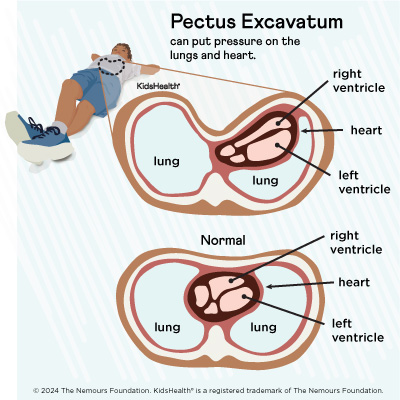
Chest Wall Disorder Pectus Excavatum For Parents Primary Children S Hospital
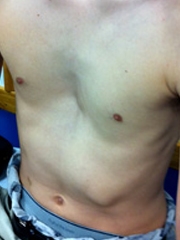
Pectus Excavatum Children S Hospital Of Philadelphia

Pectus Excavatum And Improve Your Homoeopathic Knowledge Facebook

Patient 2 Note Cafe Au Lait Spots Pectus Excavatum Widespaced Download Scientific Diagram

Pectus Excavatum Lax Abdomen Bilateral Cryptorchidism And Rocker Download Scientific Diagram
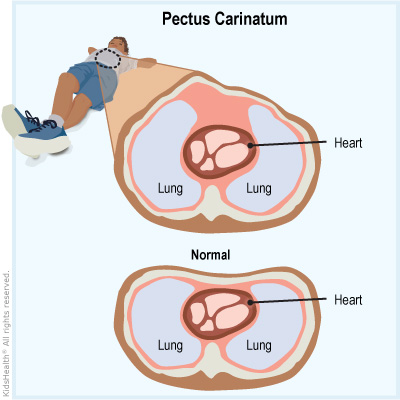
Chest Wall Disorder Pectus Carinatum For Parents Norton Children S

Full Shot And Limbs At The Age Of 9 Years A Evidence Of Pectus Download Scientific Diagram

Pectus Excavatum Chest Wall Stanford Children S Health
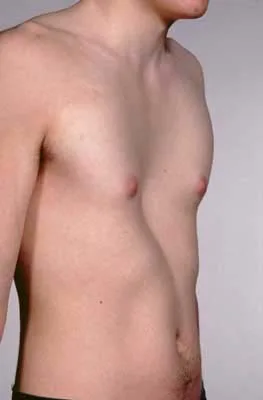
Pectus Excavatum Chest Wall Deformities Child Heart Specialist
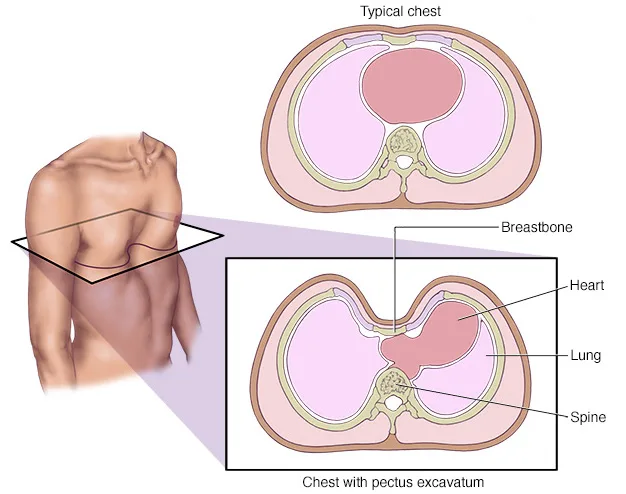
Pectus Excavatum Chest Wall Deformities Child Heart Specialist

Pectus Excavatum From A Pediatric Surgeon S Perspective Abstract Europe Pmc
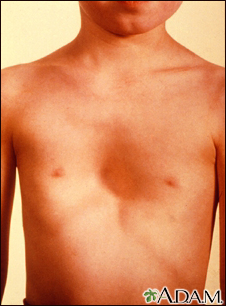
Pectus Excavatum Information Mount Sinai New York
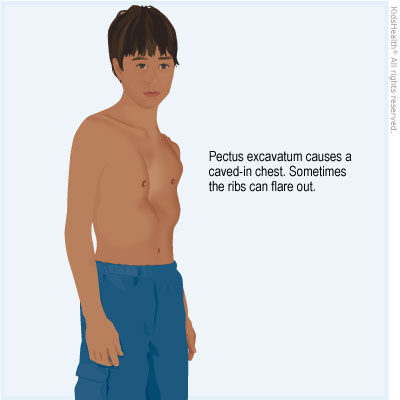
Chest Wall Disorder Pectus Excavatum For Parents Primary Children S Hospital

Pectus Excavatum Symptoms Treatments And Complications

Nuss Procedure For Pectus Excavatum Background Indications Contraindications